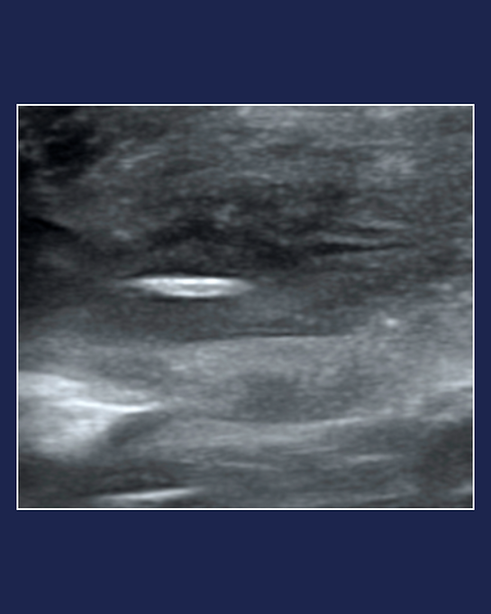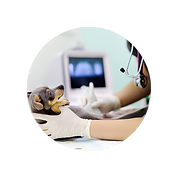Abdominal ultrasound
Abdominal ultrasound is a highly versatile imaging tool that plays a critical role in internal medicine, surgical planning and oncology patients. For internal medicine, ultrasound aids in diagnosing acute and chronic conditions, monitoring disease progression and guides targeted procedures such as biopsies and fluid sampling.
In surgical cases, it helps localise abnormalities, evaluate surgical risks and plan precise interventions. In oncology, ultrasound supports staging and monitoring, identifying primary tumours, nodal involvement, metastases and vascular invasion.
Indication examples:
-
Unexplained weight loss
-
Vomiting/diarrhoea (acute or chronic)
-
Hepatopathies / suspected liver disease
-
Pancreatitis
-
Polyuria/polydipsia (PU/PD)
-
Urinary tract disease (e.g., dysuria, haematuria)
-
Abdominal pain or palpable masses
-
Suspected pyometra
-
Fever of unknown origin (FUO)
-
Anaemia or abnormal haematology (RBC/WBC/platelets)
-
Oncology staging (e.g., mast cell tumours, lymphoma, anal sac adenocarcinoma)



Thoracic Ultrasound
Thoracic ultrasound evaluates the pleural space detecting/quantifying effusions, confirming pneumothorax and identifying loculated pockets for targeted sampling or drainage. It assesses the lung surface/parenchyma to detect consolidation (pneumonia/atelectasis), nodules/abscesses and peripheral metastases and visualises mediastinal masses/cysts and diaphragmatic hernia.
It also guides procedures, enabling safe thoracocentesis/air removal, pericardiocentesis for tamponade relief and targeted FNA of pleural/pulmonary or heart-base /pericardial lesions (as indicated).
Indication Examples:
-
Respiratory distress (dyspnoea/tachypnoea)
-
Suspected pleural disease: effusion or pneumothorax
-
Abnormal thoracic sounds or radiographs needing clarification
-
Lung surface pathology: consolidation/contusion; pulmonary oedema
-
Pleural/mediastinal masses or cranial mediastinal widening
-
Procedure guidance: thoracocentesis, pericardiocentesis* and targeted FNA/fluid sampling
Neck (Cervical) Ultrasound
Evaluates superficial and deep neck structures—lymph nodes (mandibular to medial retropharyngeal/cervical chains), thyroid/parathyroid, salivary glands, larynx/proximal trachea, and jugular/carotid vessels.
Useful to characterise masses/cysts, map lymphadenopathy, support endocrine work-ups (e.g., hyperparathyroidism), assess vascular changes (thrombus/aneurysm; Doppler as indicated), and localise foreign bodies (e.g., grass seeds). Can also guide minimally invasive procedures (FNA/aspiration; select interventional cases) where appropriate.
Indications Examples:
-
Lymphadenopathy (mandibular, medial retropharyngeal, cervical chains)
-
Thyroid/parathyroid nodules/cysts; hyperparathyroidism work-up
-
Salivary gland disease (sialocele, atrophy/fibrosis)
-
Vascular concerns (jugular/carotid thrombus, aneurysm/malformation; trauma)
-
Laryngeal/tracheal signs (voice change/stridor; suspected paralysis; mass; compression)
-
Suspected foreign body (e.g., grass seed/splinter)


Musculoskeletal Ultrasound
MSK ultrasound evaluates tendons, ligaments, muscles, bursae and peri-articular soft tissues. It helps identify tears/ fibre disruption, tendinopathy (inflammation/degeneration), mineralisation/calcification, joint effusion/synovitis, haematoma/seroma, abscesses and foreign bodies. Dynamic assessment under gentle manipulation can further localise injury.
Procedural support
Ultrasound guidance for FNA/aspiration of effusions and soft-tissue or superficial skeletal-adjacent masses; targeted sampling of lymph nodes where appropriate. If advanced orthopaedic imaging is in the patient’s best interest, we’ll recommend CT/MRI referral.
Indication Examples:
-
Lameness with focal pain/swelling
-
Suspected tendon/ligament injury
-
Joint effusion or suspected synovitis
-
Soft-tissue mass evaluation
-
Wound tracking / foreign body assessment
-
Post-op concern (swelling/fluid collection) or re-injury monitoring
Ultrasound Guided Procedures
Real-time ultrasound guidance for minimally invasive diagnostics and selected treatments.
What we support (case-dependent):
-
Fluid procedures: thoracocentesis, abdominocentesis; pericardiocentesis when appropriate
-
Targeted aspirations: cyst/abscess aspiration; cystocentesis
-
Foreign body localisation/removal (e.g., grass seed)
-
FNAs of lymph nodes: e.g., medial retropharyngeal, cervical (superficial/deep), axillary, superficial inguinal, colic/jejunal, hepatic, medial iliac
-
Targeted organ sampling: gastric/intestinal wall, liver, kidney, spleen, adrenals, and soft-tissue masses
How it works: Case review → aseptic prep & sterile probe cover → real-time needle targeting → smear/handling tips → post-procedure scan; samples go to your preferred lab.
Safety & consent: Owner consent required. We’ll flag contraindications and advise when referral (e.g., pericardial disease, cholecystocentesis in high-risk cases) is safer. Typical risks include bleeding/infection
(± pneumothorax for thoracic procedures).

How It Works
Refer A Case
We accept referrals through Form / WhatsApp or Email and discuss tailored prep information upon booking.
On-Site Scan
All scans are with a high resolution state-of-the-art portable system. All we need is you, a suitable room to work and the patient.
Deliverables
Same-day written report (PDF), images/clips supplied for upload to your PMS and
vet-to-vet case discussion.
Typical SLA: Scan before 16:00 → report by 19:00. Scan after 16:00 → by 10:00 next business day.
No, everything needed for scanning
is brought on the day.
Do we need to provide equipment?
How do we prepare the patient?
We’ll send case-specific
prep/handling notes after booking.
FNA/fluid sampling guidance is provided where appropriate; full referral recommended when best
for the patient.
Can you take samples during
the visit?
Same day for scans before 16:00; otherwise by 10:00 next business day.
When do we get the report?
How do we book?
Use the Refer a Case form, WhatsApp or Email Us. We have multiple channels to make the process as easy as possible for each clinic.
Suffolk • Norfolk • Essex Cambridgeshire • Hertfordshire
East London
Which regions do you cover?






